
文章目录
声明
本文源代码已上传至我的gitee仓库,欢迎查看:list模拟实现源代码
list的简单介绍
在学习STL时,一定要先阅读C++文档
list使用文档
- list是可以在常数范围内在任意位置进行插入和删除的序列式容器,并且该容器可以前后双向迭代
- list的底层是双向链表结构,双向链表中每个元素存储在互不相关的独立节点中,在节点中通过指针指向其前一个元素和后一个元素。
- list与forward_list非常相似:最主要的不同在于forward_list是单链表,只能朝前迭代,已让其更简单高效。
- 与其他的序列式容器相比(array,vector,deque),list通常在任意位置进行插入、移除元素的执行效率更好。
- 与其他序列式容器相比,list和forward_list最大的缺陷是不支持任意位置的随机访问,比如:要访问list的第6个元素,必须从已知的位置(比如头部或者尾部)迭代到该位置,在这段位置上迭代需要线性的时间开销;list还需要一些额外的空间,以保存每个节点的相关联信息(对于存储类型较小元素的大list来说这可能是一个重要的因素)
list的简单使用
这里罗列列表的基本操作,非常简单,相信大家在学习完string、vector后学习list的功能非常简单
cpp
# define _CRT_SECURE_NO_WARNINGS
#include<iostream>
#include<list>
using namespace std;
int main()
{
list<int> lt;
lt.push_back(1);
lt.push_back(2);
lt.push_back(3);
lt.push_back(4);
lt.push_back(5);
//迭代器
list<int>::iterator it = lt.begin();
while (it != lt.end())
{
cout << *it << " ";
it++;
}
cout << endl;
//范围for
for (auto e : lt)
{
cout << e << " ";
}
cout << endl;
//逆置
lt.reverse();
for (auto e : lt)
{
cout << e << " ";
}
cout << endl;
//排序
lt.sort();
for (auto e : lt)
{
cout << e << " ";
}
cout << endl;
//节点转移
list<int> lt1;
lt1.push_back(10);
lt1.push_back(20);
lt1.push_back(30);
lt1.push_back(40);
lt.splice(lt.begin(), lt1);
for (auto e : lt)
{
cout << e << " ";
}
cout << endl;
for (auto e : lt1)
{
cout << e << " ";
}
cout << endl;
return 0;
}运行结果:
cpp
1 2 3 4 5
1 2 3 4 5
5 4 3 2 1
1 2 3 4 5
10 20 30 40 1 2 3 4 5list中sort效率测试
表示双向循环链表以及数据初始化:
cpp
void test_op()
{
srand((unsigned int)time(NULL));
const int N = 1000000;
vector<int> v;
v.reserve(N);
list<int> lt1;
list<int> lt2;
for (int i = 0; i < N; ++i)
{
int e = rand();
lt1.push_back(e);
lt2.push_back(e);
}
// 拷贝到vector排序,排完以后再拷贝回来
int begin1 = clock();
for (auto e : lt1)
{
v.push_back(e);
}
sort(v.begin(), v.end());
size_t i = 0;
for (auto& e : lt1)
{
e = v[i++];
}
int end1 = clock();
//list调用自己的sort
int begin2 = clock();
lt2.sort();
int end2 = clock();
printf("vector sort:%d\n", end1 - begin1);
printf("list sort:%d\n", end2 - begin2);
}测试结果发现,list的sort排序效率很低,在实际应用中使用的很少
list的简单模拟
cpp
template<class T>
struct ListNode
{
ListNode<T>* _next;
ListNode<T>* _prev;
T _data;
ListNode(const T& x = T())
:_next(nullptr)
, _prev(nullptr)
, _data(x)
{}
};模板类ListNode表示双向链表中的节点。该节点包括三个成员:_next(指向下一个节点的指针)、_prev(指向上一个节点的指针)和 _data(存储节点的数据)。
定义了一个构造函数,用于初始化节点的数据成员,如果不提供具体的数据,则使用默认值进行初始化。
实现简单的双向循环链表:
cpp
template<class T>
class list
{
typedef ListNode<T> Node;
public:
list()
{
_head = new Node;
_head->_next = _head;
_head->_prev = _head;
}
void push_back(const T& x)
{
Node* newnode = new Node(x);
Node* tail = _head->_prev;
tail->_next = newnode;
newnode->_next = _head;
_head->_prev = newnode;
}
private:
Node* _head;
};定义了一个模板类 list,实现了简单的双向循环链表。在 list 中,使用了之前定义的 ListNode 作为节点,通过模板类的方式实现了对不同类型元素的支持。
构造函数中,创建了一个头节点,并将头节点的 _next 和 _prev 都指向自身,构成一个空的循环链表。
list(): 这是类的构造函数,用于初始化链表。在构造函数中,首先创建了一个头节点 _head,然后将头节点的 _next 和 _prev 都指向自身,从而形成一个空的循环链表。
void push_back(const T& x): 这是一个成员函数,用于在链表尾部插入新的元素。在函数中,首先创建了一个新的节点 newnode 并存储数据 x,然后找到当前尾节点 tail,将尾节点的 _next 指向新节点,新节点的 _next 指向头节点,头节点的 _prev 指向新节点,从而完成了新元素的插入。
封装迭代器
封装迭代器:
- 定义了一个名为
ListIterator的模板类
cpp
template<class T>
class ListIterator
{
typedef ListNode<T> Node;
typedef ListIterator<T> Self;
Node* _node;typedef ListIterator<T> Self;:定义了一个别名Self,它代表了当前类的类型,这样就可以在类内部使用Self来引用当前类的对象。
Node* _node;:声明了一个指针成员变量_node,它用于指向链表中的节点。
- 成员函数的定义:
cpp
public:
ListIterator(Node* node)
:_node(node)
{}构造函数ListIterator(Node* node):接受一个指向链表节点的指针作为参数,将其赋值给成员变量_node。
cpp
T& operator*()
{
return _node->_data;
}解引用操作符operator*():返回当前迭代器指向的节点的数据成员的引用。
cpp
Self& operator++()
{
_node = _node->_next;
return *this;
}前置递增操作符operator++():将迭代器指向下一个节点,并返回递增后的迭代器自身的引用。
cpp
Self operator++(int)
{
Self tmp(*this);
_node = _node->_next;
return tmp;
}后置递增操作符operator++(int):创建当前迭代器的副本tmp,然后将迭代器指向下一个节点,并返回tmp。
cpp
Self& operator--()
{
_node = _node->_prev;
return *this;
}
Self operator--(int)
{
Self tmp(*this);
_node = _node->_prev;
return tmp;
}置和后置递减操作符的定义与递增操作符类似,只不过是将迭代器指向前一个节点。
cpp
bool operator!=(const Self& it)
{
return _node != it._node;
}
};不等于操作符operator!=:比较两个迭代器的_node成员,如果它们不相等,则返回true;否则返回false。
源代码:
cpp
template<class T>
struct ListConstIterator
{
typedef ListNode<T> Node;
typedef ListConstIterator<T> Self;
Node* _node;
ListConstIterator(Node* node)
:_node(node)
{}
// *it
const T& operator*()
{
return _node->_data;
}
// it->
const T* operator->()
{
return &_node->_data;
}
// ++it
Self& operator++()
{
_node = _node->_next;
return *this;
}
Self operator++(int)
{
Self tmp(*this);
_node = _node->_next;
return tmp;
}
Self& operator--()
{
_node = _node->_prev;
return *this;
}
Self operator--(int)
{
Self tmp(*this);
_node = _node->_prev;
return tmp;
}
bool operator!=(const Self& it)
{
return _node != it._node;
}
bool operator==(const Self& it)
{
return _node == it._node;
}
};关于链表开始和结束的定义:
cpp
typedef ListConstIterator<T> iterator;
iterator begin()
{
return iterator(_head->_next);
}
iterator end()
{
return iterator(_head);
}begin()函数返回一个迭代器,它指向链表中的第一个元素(也就是头节点的下一个节点)。
end()函数返回一个迭代器,它指向链表中最后一个元素的下一个位置(也就是头节点本身)。
insert模拟
模拟实现insert:
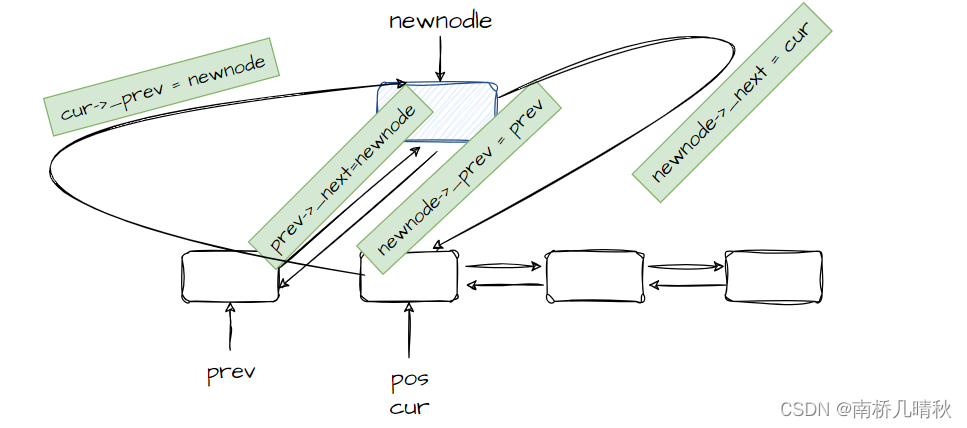
cpp
void insert(iterator pos, const T& val)
{
Node* cur = pos._node;
Node* newnode = new Node(val);
Node* prev = cur->_prev;
//prev newnode cur
prev->_next = newnode;
newnode->_prev = prev;
newnode->_next = cur;
cur->_prev = newnode;
}erase模拟
模拟实现erase:
cpp
iterator earse(iterator pos)
{
Node* cur = pos._node;
Node* prev = cur->_prev;
Node* next = cur->_next;
prev->_next = next;
next->_prev = prev;
delete cur;
return iterator(next);
}注意:最后,返回一个指向下一个节点的迭代器,以便在调用方继续操作链表。
头插、尾插、头删、尾删模拟
在刚刚插入和删除的基础上,模拟实现头插、尾插、头删、尾删:
cpp
void push_back(const T& x)
{
insert(end(), x);
}
void push_front(const T& x)
{
insert(begin(), x);
}
void pop_back()
{
erase(--end());
}
void pop_front()
{
erase(begin());
}自定义类型迭代器遍历
自定义一个结构体A,然后进行插入删除操作:
cpp
struct A
{
int _a1;
int _a2;
A(int a1=0,int a2=0)
:_a1(a1)
,_a2(a2)
{}
};
void test_list2()
{
list<A> lt;
A aa1(1, 1);
A aa2 = { 2,2 };
lt.push_back(aa1);
lt.push_back(aa1);
lt.push_back(A(2, 2));
lt.push_back({ 3,3 });
lt.push_back({ 4,4 });
list<A>::iterator it = lt.begin();
while (it != lt.end())
{
cout << *it << " ";
++it;
}
cout << endl;
}运行一下,报错了!!!
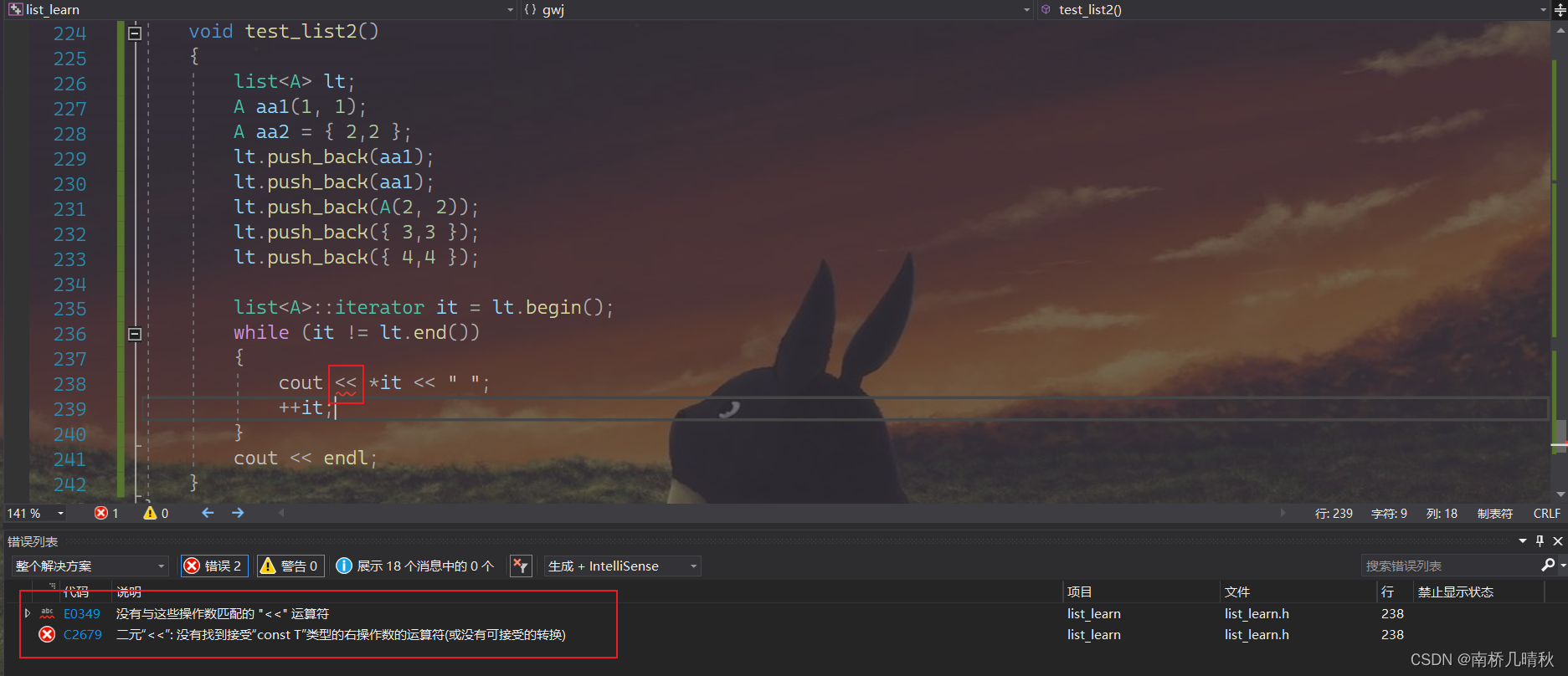
解决方法有两种:
- 第一种:
在循环内部,通过cout << (*it)._a1 << ":" << (*it)._a2 << endl;语句打印当前迭代器it指向的A类型对象的_a1和_a2成员变量的值,中间用冒号分隔,并在末尾换行。这里使用了解引用操作符(*)来获取迭代器指向的对象,然后通过点操作符(.)访问对象的成员变量_a1和_a2
(*it)._a1:(*it)是迭代器it指向的元素,即链表中的一个A类型对象,.是成员访问运算符,_a1是这个A类型对象的成员变量_a1的值。所以(*it)._a1表示获取当前迭代器指向的对象的_a1成员变量的值。
cpp
void test_list2()
{
list<A> lt;
A aa1(1, 1);
A aa2 = { 2,2 };
lt.push_back(aa1);
lt.push_back(aa1);
lt.push_back(A(2, 2));
lt.push_back({ 3,3 });
lt.push_back({ 4,4 });
list<A>::iterator it = lt.begin();
while (it != lt.end())
{
cout << (*it)._a1 << ":" << (*it)._a2 << endl;
++it;
}
cout << endl;
}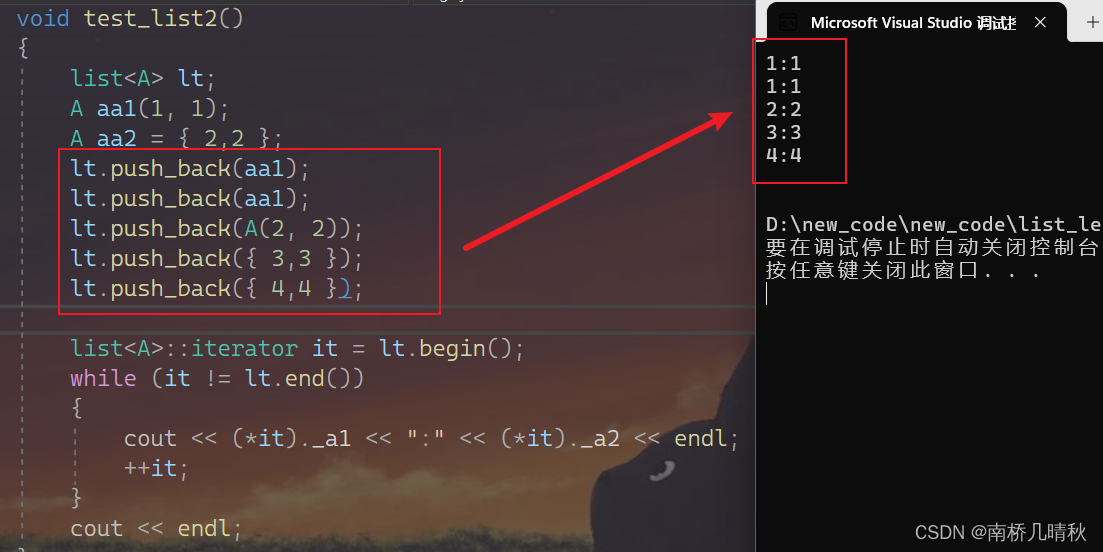
- 第二种:
定义了一个operator->()重载函数,箭头运算符用于访问对象的成员,而对于指向对象的指针,使用箭头运算符来访问成员会更方便
const T*: 这是函数的返回类型,表示返回一个指向类型为T的常量数据的指针。也就是说,该函数返回的是一个指向T类型常量数据的指针。
operator->(): 这是重载的箭头运算符函数名。当我们通过指向某个对象的指针使用箭头运算符时,就会调用此函数来执行操作。
{ return &_node->_data; }: 函数体内部,返回了一个指向_node->_data的指针。在这里,_node是一个指向节点的指针,_data是节点中存储的数据。通过返回&_node->_data,实际上是返回了指向节点数据的指针。
cpp
// it->
const T* operator->()
{
return &_node->_data;
}遍历:
cpp
void test_list2()
{
list<A> lt;
A aa1(1, 1);
A aa2 = { 2,2 };
lt.push_back(aa1);
lt.push_back(aa1);
lt.push_back(A(2, 2));
lt.push_back({ 3,3 });
lt.push_back({ 4,4 });
list<A>::iterator it = lt.begin();
while (it != lt.end())
{
cout << it->_a1 << ":" << it->_a2 << endl;
++it;
}
cout << endl;
}it->_a1和it->_a2就是使用迭代器it来访问链表中当前元素的成员变量_a1和_a2的值。这里的it->_a1和it->_a2相当于(*it)._a1和(*it)._a2
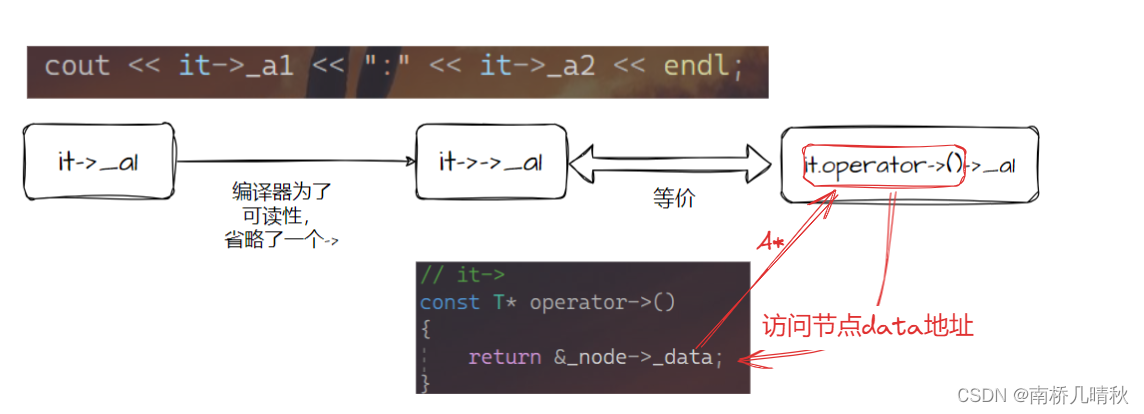
const迭代器
cont迭代器是迭代器指向的内容不能修改
注意:
const_iterator是迭代器指向的内容不能修改,迭代器指向的元素不可修改,模拟实现的是const T* p2const iterator是迭代器本身不能修改,这个const修饰的是iterator,iterator是自定义类型,前面加了const那就是不能修改这个自定义类型,模拟实现的是T* const p1
cpp
const_iterator begin() const
{
return iterator(_head->_next);
}
const_iterator end() const
{
return iterator(_head);
}
cpp
void PrintList(const list<int>& clt)
{
list<int>::const_iterator it = clt.begin();
while (it != clt.end())
{
cout << *it << " ";
++it;
}
cout << endl;
}
void test_list3()
{
list<int> lt;
lt.push_back(1);
lt.push_back(2);
lt.push_back(3);
lt.push_back(4);
lt.push_back(5);
PrintList(lt);
}使用模板封装一个迭代器:
cpp
template<class T, class Ref, class Ptr>
struct ListIterator
{
typedef ListNode<T> Node;
typedef ListIterator<T, Ref, Ptr> Self;
Node* _node;
ListIterator(Node* node)
:_node(node)
{}
// *it
//T& operator*()
Ref operator*()
{
return _node->_data;
}
// it->
//T* operator->()
Ptr operator->()
{
return &_node->_data;
}
// ++it
Self& operator++()
{
_node = _node->_next;
return *this;
}
Self operator++(int)
{
Self tmp(*this);
_node = _node->_next;
return tmp;
}
Self& operator--()
{
_node = _node->_prev;
return *this;
}
Self operator--(int)
{
Self tmp(*this);
_node = _node->_prev;
return tmp;
}
bool operator!=(const Self& it)
{
return _node != it._node;
}
bool operator==(const Self& it)
{
return _node == it._node;
}
};template<class T, class Ref, class Ptr>:模板声明,用来定义模板类 ListIterator,它有三个模板参数 T、Ref 和 Ptr。
在这个模板类中,class T、class Ref 和 class Ptr 是模板参数,它们的作用如下:
T:表示节点中存储的数据类型。通过模板参数 T,可以让 ListIterator 类型适用于不同类型的链表,例如整数、字符串、自定义对象等。Ref:表示引用类型。在 C++ 中,引用类型通常用来表示对某个对象的引用,通过模板参数Ref,可以指定迭代器返回的数据的引用类型,例如T&(对T类型的对象的引用)。Ptr:表示指针类型。通过模板参数Ptr,可以指定迭代器返回数据的指针类型,例如T*(指向T类型的指针)。
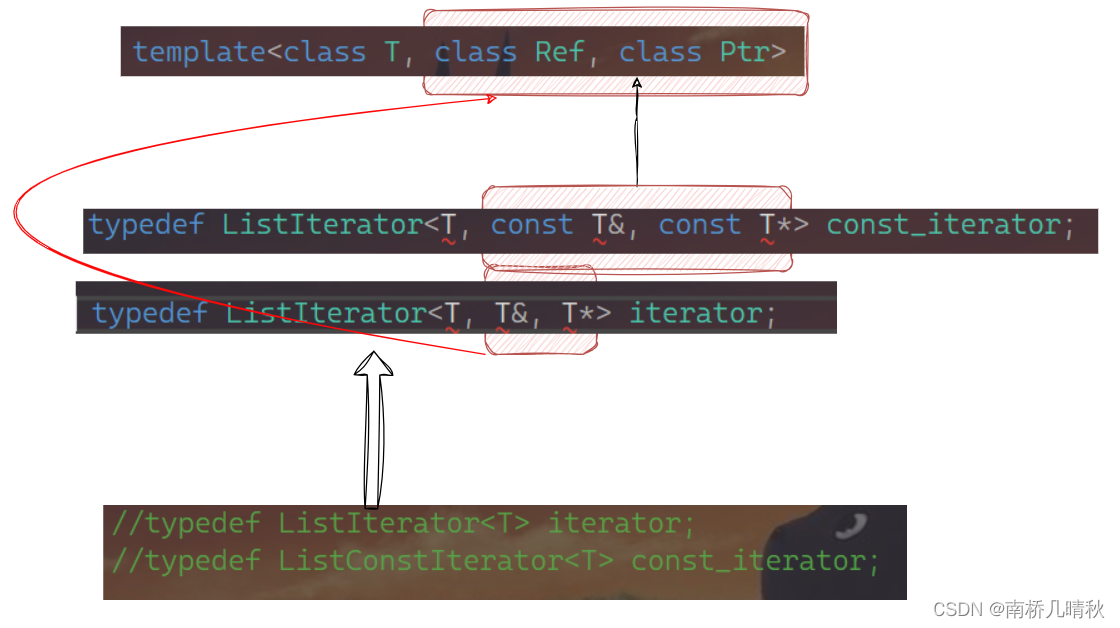
clear和析构函数
cpp
void clear()
{
iterator it = begin();
while (it != end())
{
it = erase(it);
}
}
~list()
{
clear();
delete _head;
_head = nullptr;
}-
clear() 方法:
首先创建一个迭代器 it 并初始化为链表的头部(即第一个节点)。
然后通过循环遍历链表中的每个节点,调用 erase() 方法来删除当前节点,并将返回的下一个节点的迭代器赋值给 it。
循环直到 it == end(),即遍历完整个链表。
-
析构函数 ~list():
在析构函数中首先调用 clear() 方法,清空链表中的所有节点。
然后释放链表的头节点 _head 所占用的内存,避免内存泄漏。
最后将 _head 指针设置为 nullptr,确保不再指向已释放的内存。
通过在析构函数中调用 clear() 方法,可以确保在销毁链表对象时,先清空链表中的所有节点,然后再释放头节点的内存。这样做有助于避免内存泄漏,并正确地释放链表所占用的资源。
拷贝构造(传统写法)
cpp
void empty_init()
{
_head = new Node;
_head->_next = _head;
_head->_prev = _head;
_size = 0;
}
list()
{
empty_init();
}
// lt2(lt1)
list(const list<T>& lt)
{
empty_init();
for (auto& e : lt)
{
push_back(e);
}
}-
empty_init() :
初始化空的链表。它创建了一个新的节点作为头结点,并将头结点的指针指向自己,形成一个循环链表。同时,将链表的大小 _size 初始化为 0。
-
默认构造函数 list():
在这个构造函数中,它调用了 empty_init() 方法来初始化一个空的链表。
-
拷贝构造函数 list(const list& lt):
这个构造函数通过调用 empty_init() 方法来初始化一个空的链表(即新建一个头结点)。然后通过遍历传入的链表 lt,将其中的元素逐个添加到新建的链表中,使用 push_back(e) 方法将元素添加到新链表的末尾。
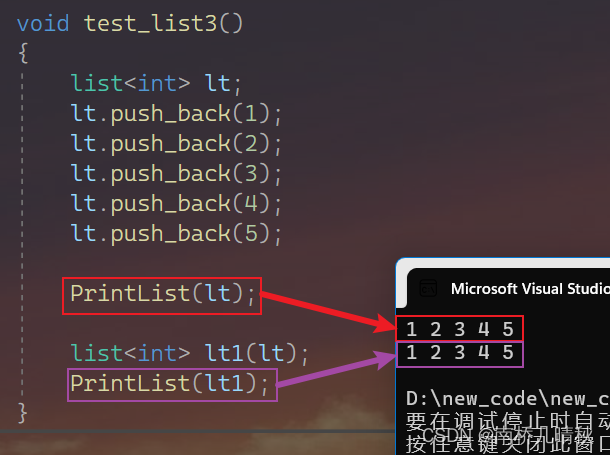
拷贝构造(现代写法)
cpp
void swap(list<T>& lt)
{
std::swap(_head, lt._head);
std::swap(_size, lt._size);
}
// lt1 = lt3
list<T>& operator=(list<T> lt)
{
swap(lt);
return *this;
}-
swap:
交换两个链表对象的内容。它通过调用
std::swap函数交换当前链表对象的头结点_head和大小_size与传入的链表对象lt的对应成员的值。这样可以在不需要额外内存分配的情况下快速交换两个链表的内容。 -
赋值运算符重载函数
operator=:这个赋值运算符重载函数接受一个传值参数
lt,在函数内部会对传入的链表 lt 调用swap方法,将传入链表的内容与当前链表对象进行交换。通过传值参数的方式,会触发拷贝构造函数,从而创建传入链表
lt的一个副本。然后,调用swap(lt)来交换当前链表对象和副本链表对象的内容,最终实现将传入链表lt中的内容赋值给当前链表对象。最后,返回
*this,即当前链表对象的引用,以支持链式赋值操作。
源码
cpp
#pragma once
#include<assert.h>
namespace gwj
{
template<class T>
struct ListNode
{
ListNode<T>* _next;
ListNode<T>* _prev;
T _data;
ListNode(const T& x = T())
:_next(nullptr)
, _prev(nullptr)
, _data(x)
{}
};
//typedef ListIterator<T, T&, T*> iterator;
//typedef ListIterator<T, const T&, const T*> const_iterator;
template<class T, class Ref, class Ptr>
struct ListIterator
{
typedef ListNode<T> Node;
typedef ListIterator<T, Ref, Ptr> Self;
Node* _node;
ListIterator(Node* node)
:_node(node)
{}
// *it
//T& operator*()
Ref operator*()
{
return _node->_data;
}
// it->
//T* operator->()
Ptr operator->()
{
return &_node->_data;
}
// ++it
Self& operator++()
{
_node = _node->_next;
return *this;
}
Self operator++(int)
{
Self tmp(*this);
_node = _node->_next;
return tmp;
}
Self& operator--()
{
_node = _node->_prev;
return *this;
}
Self operator--(int)
{
Self tmp(*this);
_node = _node->_prev;
return tmp;
}
bool operator!=(const Self& it)
{
return _node != it._node;
}
bool operator==(const Self& it)
{
return _node == it._node;
}
};
//template<class T>
//struct ListConstIterator
//{
// typedef ListNode<T> Node;
// typedef ListConstIterator<T> Self;
// Node* _node;
// ListConstIterator(Node* node)
// :_node(node)
// {}
// // *it
// const T& operator*()
// {
// return _node->_data;
// }
// // it->
// const T* operator->()
// {
// return &_node->_data;
// }
// // ++it
// Self& operator++()
// {
// _node = _node->_next;
// return *this;
// }
// Self operator++(int)
// {
// Self tmp(*this);
// _node = _node->_next;
// return tmp;
// }
// Self& operator--()
// {
// _node = _node->_prev;
// return *this;
// }
// Self operator--(int)
// {
// Self tmp(*this);
// _node = _node->_prev;
// return tmp;
// }
// bool operator!=(const Self& it)
// {
// return _node != it._node;
// }
// bool operator==(const Self& it)
// {
// return _node == it._node;
// }
//};
template<class T>
class list
{
typedef ListNode<T> Node;
public:
//typedef ListIterator<T> iterator;
//typedef ListConstIterator<T> const_iterator;
typedef ListIterator<T, T&, T*> iterator;
typedef ListIterator<T, const T&, const T*> const_iterator;
//iterator begin()
//{
// //return iterator(_head->_next);
// iterator it(_head->_next);
// return it;
//}
iterator begin()
{
return _head->_next;
}
iterator end()
{
return _head;
}
// const迭代器,需要是迭代器不能修改,还是迭代器指向的内容?
// 迭代器指向的内容不能修改!const iterator不是我们需要const迭代器
// T* const p1
// const T* p2
const_iterator begin() const
{
return _head->_next;
}
const_iterator end() const
{
return _head;
}
void empty_init()
{
_head = new Node;
_head->_next = _head;
_head->_prev = _head;
_size = 0;
}
list()
{
empty_init();
}
// lt2(lt1)
list(const list<T>& lt)
{
empty_init();
for (auto& e : lt)
{
push_back(e);
}
}
void swap(list<T>& lt)
{
std::swap(_head, lt._head);
std::swap(_size, lt._size);
}
// lt1 = lt3
list<T>& operator=(list<T> lt)
{
swap(lt);
return *this;
}
// 需要析构,一般就需要自己写深拷贝
// 不需要析构,一般就不需要自己写深拷贝,默认浅拷贝就可以
void clear()
{
iterator it = begin();
while (it != end())
{
it = erase(it);
}
}
~list()
{
clear();
delete _head;
_head = nullptr;
}
//void push_back(const T& x)
//{
// Node* newnode = new Node(x);
// Node* tail = _head->_prev;
// tail->_next = newnode;
// newnode->_next = _head;
// _head->_prev = newnode;
//}
void push_back(const T& x)
{
insert(end(), x);
}
void push_front(const T& x)
{
insert(begin(), x);
}
void pop_back()
{
erase(--end());
}
void pop_front()
{
erase(begin());
}
void insert(iterator pos, const T& val)
{
Node* cur = pos._node;
Node* newnode = new Node(val);
Node* prev = cur->_prev;
//prev newnode cur
prev->_next = newnode;
newnode->_prev = prev;
newnode->_next = cur;
cur->_prev = newnode;
_size++;
}
iterator erase(iterator pos)
{
Node* cur = pos._node;
Node* prev = cur->_prev;
Node* next = cur->_next;
prev->_next = next;
next->_prev = prev;
delete cur;
_size--;
return iterator(next);
}
bool empty()
{
return _size == 0;
}
private:
Node* _head;
size_t _size;
};
void test_list1()
{
list<int> lt;
lt.push_back(1);
lt.push_back(2);
lt.push_back(3);
lt.push_back(4);
lt.push_back(5);
list<int>::iterator it = lt.begin();
while (it != lt.end())
{
cout << *it << " ";
++it;
}
cout << endl;
lt.push_front(10);
lt.push_front(20);
lt.push_front(30);
for (auto e : lt)
{
cout << e << " ";
}
cout << endl;
lt.pop_back();
lt.pop_front();
for (auto e : lt)
{
cout << e << " ";
}
cout << endl;
}
struct A
{
int _a1;
int _a2;
A(int a1=0,int a2=0)
:_a1(a1)
,_a2(a2)
{}
};
void test_list2()
{
list<A> lt;
A aa1(1, 1);
A aa2 = { 2,2 };
lt.push_back(aa1);
lt.push_back(aa1);
lt.push_back(A(2, 2));
lt.push_back({ 3,3 });
lt.push_back({ 4,4 });
list<A>::iterator it = lt.begin();
while (it != lt.end())
{
//cout << (*it)._a1 << ":" << (*it)._a2 << endl;
cout << it->_a1 << ":" << it->_a2 << endl;
++it;
}
cout << endl;
}
void PrintList(const list<int>& clt)
{
list<int>::const_iterator it = clt.begin();
while (it != clt.end())
{
cout << *it << " ";
++it;
}
cout << endl;
}
void test_list3()
{
list<int> lt;
lt.push_back(1);
lt.push_back(2);
lt.push_back(3);
lt.push_back(4);
lt.push_back(5);
PrintList(lt);
list<int> lt1(lt);
PrintList(lt1);
}
}